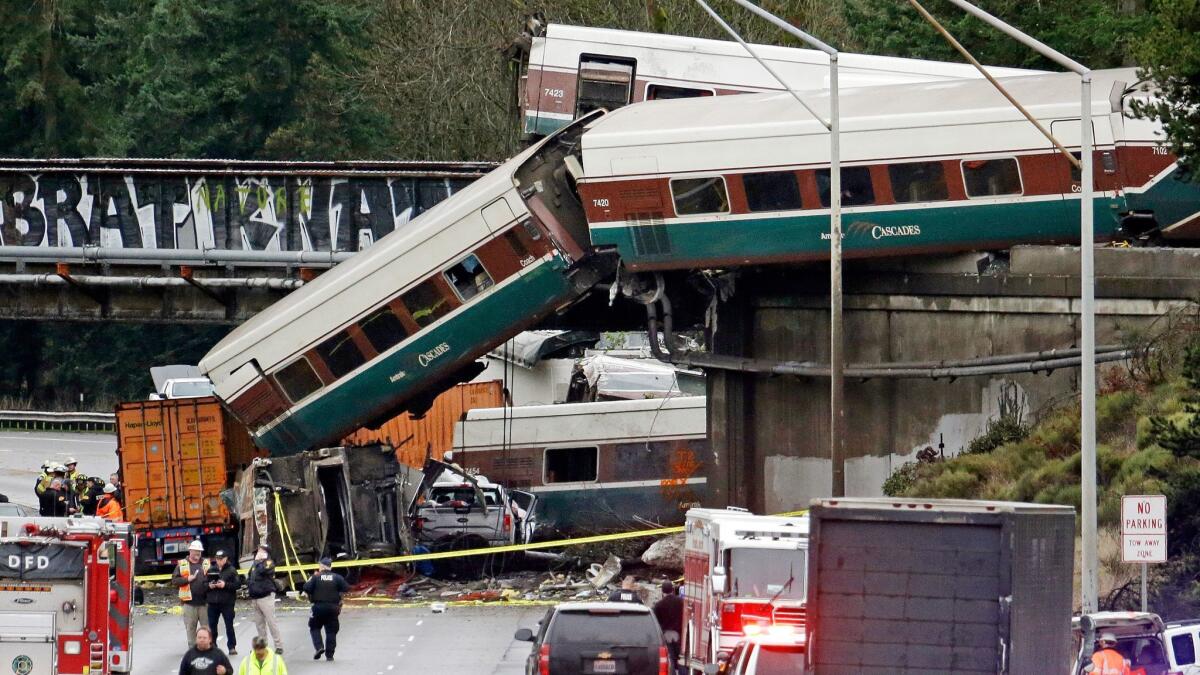Engineer in fatal Washington Amtrak crash says he didn’t notice sign warning of excessive speed

The engineer at the throttle of an Amtrak train that flew off a curve and crashed in Washington state last month, killing three and injuring dozens, has told federal investigators he missed — or misinterpreted — a sign that might have alerted him to the passenger train’s dangerous speed, nearly 50 mph over the safe limit.
The National Transportation Safety Board has determined Amtrak Cascades train No. 501 was going almost 80 mph when it zipped past the sign limiting speeds to 30 mph. It was the train’s inaugural trip on a new route and included a happy crowd of commuters and train enthusiasts. The three who died all bought tickets to be among the first to experience and celebrate the new route.
Amtrak officials have said they undertook extensive trial runs to prepare for the route.
But in an investigative update issued Thursday, the NTSB said the 55-year-old engineer, whose name was not released, told investigators last week that it was only his second time at the throttle southbound on the new stretch of tracks between Seattle and Portland. He had been at the controls for two practice runs northbound as well, he said.
“The engineer told investigators that he was aware that the curve with the 30 mph speed restriction was at milepost 19.8, and that he had planned to initiate braking about one mile prior to the curve,” the report said.
“The engineer said that he saw mileposts 16 and 17 but didn’t recall seeing milepost 18 or the 30 mph speed sign, which was posted two miles ahead of the speed-restricted curve.” He did see a signal near 19.8 milepost “but mistook it for another signal, which was north of the curve.”
The report continued: “He said that as soon as he saw the 30 mph sign at the start of the curve, he applied the brakes. Seconds later, the train derailed as it entered the curve. …The engineer also said that he would not have gotten behind the throttle if he had any reservations about his readiness to operate the train.”
The agency did not speculate on what might have distracted the engineer. The NTSB said in a preliminary report in December that he was not using his cellphone when the accident occurred.
One other person, a train conductor, was also in the locomotive at the time of the crash. He heard the engineer say or mumble something, looked up and then sensed that the train was becoming “airborne,” the report said.
The train left the tracks, continuing straight ahead, half of it landing on and near Interstate 5 during the Dec. 18 morning rush hour in DuPont, Wash. Some cars were left dangling off the left side of a trestle over the roadway. Of the 14 rail cars, only the rear locomotive was left standing.
Most of the 77 passengers and several motorists suffered minor to major injuries, tossed around amid broken glass, flying metal and cars turned upside down without lights.
The three who died — all of them train buffs — were Jim Hamre, 61; Zack Willhoite, 35; and Benjamin Gran, 40. Hamre and Willhoite, both from the Tacoma area, were friends and members of All Aboard Washington, a rail enthusiasts group. Their volunteer efforts helped establish the new, faster route they died on. Gran, of nearby Auburn, was described by a relative as “an Amtrak fan to the max.”
The new, $180-million track south of Tacoma, known as the Point Defiance Bypass, was created to make train travel safer and faster, cutting 10 minutes off the Seattle-Portland jaunt.
The conductor and the engineer were both seriously injured, leading to almost a month’s delay before officials could talk with them. The conductor, Garrick Freeman, 48, is among at least 12 employees or passengers who’ve filed lawsuits against Amtrak so far. He is one of four Amtrak employees suing over injuries suffered in the crash. One passenger, a teen boy, is still in the hospital, paralyzed by the crash.
Transportation experts have said that the crash could have been avoided if a partially installed high-tech braking system had been operational. “Positive train control” technology senses when to slow trains that are going too fast, should engineers become ill or distracted.
Such a system, available since the 1970s, probably could have prevented at least two dozen crashes over the last 20 years, officials say. The railroad industry began to see the benefits of safer trains and lower costs from accidents after the collision of a freight train and a Los Angeles Metrolink commuter train in 2008. An investigation determined the train’s engineer was texting on his phone, ran a stop signal and caused the death of 25 commuters.
The auto-braking system on the Point Defiance Bypass was to be installed by the end of 2018, but is now being rushed to completion and could be available on the route within a few months.
Anderson is a special correspondent.
More to Read
Start your day right
Sign up for Essential California for news, features and recommendations from the L.A. Times and beyond in your inbox six days a week.
You may occasionally receive promotional content from the Los Angeles Times.






